
HEMP TEXTILE ROOM
USA Hemp Museum Store - Bookmark This Site - Museum Link - Email The Museum
 |
HEMP TEXTILE ROOM USA Hemp Museum Store - Bookmark This Site - Museum Link - Email The Museum |
|
HEMP TEXTILE HISTORY |
|
The following are hemp references from: THE BOOK OF FINE
LINEN, Page 70: "For in trying to recount the origins of linen and fabrics, the storyteller confronts the irreparable damage of time. Textiles are the most perishable of materials, and so from the Neolithic Age (when archaeologists think mankind first began to weave flax and hemp) to the end of the Middle Ages, the history of fabrics is recorded on just a few shreds of cloth whose exact features are difficult to determine." |
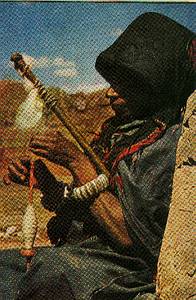 |
A hand spinner of today uses an ages
old technique with her tools. Fiber unknown.
Life magazine photo in the Hemp Museum. |
|
Page 70: " from the thirteenth century onwards documents known as death inventories provide an incomplete picture, yet it permits an assessment of the quantity and type of items found in the linen chests of medieval kings and nobility, and later of the rich bourgeoisie. For it should be obvious that only the linen of the rich was preserved. That belonging to the poor -scant, dirty, worn, and generally made of hemp- did not last long enough to be bequeathed." [And of course these latter linens, made of hemp, were in great demand as rags for the making of paper, which helps account for their not being bequeathed.] Page 70: "From the Middle Ages to the end of the nineteenth century, the most commonly used fiber was flax, followed by a significant amount of the less costly hemp." Page 74: "The seam down the middle of this hemp-and-linen bottom sheet (right {picture}) is an admirable piece of workmanship. Here we see the back of the seam, the front being nearly invisible. Such sheets only disappeared, alone with traditional trousseaux, in the late 1930's." Page 74: "Starting around 1322. The finest sheets were of linen, most were of hemp, and the poorest woven from tow, scrap hemp, or flax combings." Page 76: "...up to the end of the seventeenth century, sheets were generally made from linen or hemp. Historians, citing the fact that the founding of the hemp-weavers guild long predated that of the linen-weavers, believe that hemp was far more common than linen until the late fourteenth century." Page 76: "In the hierarchy of textiles, linen and hemp cloth were followed by fabrics made from tow (hemp) and canvas (hemp), theoretically aimed at modest folk. The finest linen fabrics were always identified by their place of origin. " Page 84: "During the nineteenth century, the linen in homes piled ever higher. A rich town-dweller's trousseau at the turn of the century might include 96 sheets for family use and 60 sheets for the servants. But the growing stack of linen were not only found in the cities, they were also accumulated in country cupboards. Some historians see this oversupply as a way of absorbing local production of flax and hemp, for want of broader markets." |
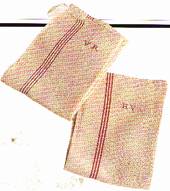 |
Page 124: "The two heirloom dish towels (preceding page {pictured}) are examples of home-woven linen formerly produced in rural France. They bear the traditional decoration of red bands and cross-stitched initials. The one marked HV is of pure hemp, while the one marked VR is a hemp-and-linen blend." |
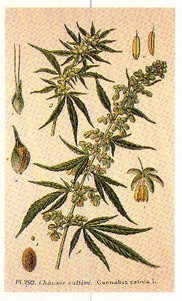 |
Page 124: "Hemp, or Cannabis sativa, (left {pictured}) has long been appreciated not only for its narcotic properties, but also for the oil from its seed and the textile fibers from its stalk. As raw material for textiles, hemp is grown in Europe from the northern Baltic region to southern Italy." |
|
Page 124: " Fabrics appeal to the sense of touch. Hemp is reputed to be coarse, linen cool yet alive, cotton is soft and warm, silk smooth and velvety. The universal language of fabrics has been spoken at all times, in all places, among every group of people, regardless of the raw material available to them. Fabrics are present every moment of the day and night; they witness life's most intimate scenes, thereby weaving a very special relationship with each individual.Fabrics cover and warm. Touching and feeling them is reassuring, as children demonstrate when they choose bits of soft, often ragged material to clutch and stroke as they fall asleep. The invention of fabrics dates from the dawn of civilization, probably as a result of braiding plant fibers to make nets, ropes, baskets, and wicker objects. The actual weaving of fabrics appeared nearly everywhere in the world during, or just prior to, the third millennium B.C. But of the approximately seven hundred fibrous plants that could have been spun into thread, only half a dozen were commonly employed: cotton, flax, hemp, jute, sisal, and ramie. The current vogue for ecology has led to attempts to revive the use of hemp and ramie in the production of fabrics with new textures, especially for the making of tablecloths. For centuries, however, the standard plants used for household linen were hemp and flax, until cotton (pure or blended with synthetic fibers) finally took the lead." Page 124: "HEMP AND FLAX: While recent fashion has tried to re-establish hemp =s pedigree, the plant is no longer grown in Europe for textile purposes, although hemp fibers are still used for manufacturing paper pulp and hemp seed serves as livestock fodder. Coarse dish towels, bath linen, and bed sheets, which were rough on the skin, disappeared from the bridal trousseaux long ago. That explains why even specialist boutiques offer very little antique household linen made from hemp.The first use of hemp probably dates all the way back to the third millennium B.C., somewhere in central Asia. Despite its notorious reputation for coarseness, Herodotus noted that skillful Scythians and Thracians in the fifth century B.C. were able to weave fine cloth from hemp: >Someone without great experience would not recognize whether they were of hemp or linen, and whoever has not yet seen hemp cloth would think the garments were of linen.= In medieval Europe, hemp was used to make underclothing and household linen, as well as rope (rope-making was the only trade that lepers in Brittany were allowed to practice). Brownish-gray in color, thicker and coarser than linen when new, hemp cloth was often preferred by religious communities and, due to its much lower cost, by the poor. An anecdote asserts that Marie de Medici kept two hemp blouses among her magnificently rich trousseau-perhaps for doing penance. However, anyone lucky enough to touch a length of aged, well-used hemp cloth is amazed by the extreme softness and substantial drape of the fabric, which is similar to that of heavy flannel. Throughout history hemp was used more widely in the countryside than in towns, since every farm had its field of hemp (and perhaps another of flax) designed to meet the daily household fabric requirements and to supply part of the daughters= bridal trousseaux." ***** |
| A page from THE STORY OF HEMP IN
COLONIAL VIRGINIA, a dissertation by George Melvin Herndon,
1959, University of Virginia, gives a picture of hemp in early
America. Chapter 6, p. 153: "Prior to the Revolution, hemp had become a major staple in the Valley (Shenandoah Valley) and one of a number of crops supplementary to tobacco in other areas. It was also a source of supply for a certain amount of home manufacturing carried on to some degree by all families, and at least a limited supply was needed for various and sundry purposes on the farms and plantations. Pre-Revolutionary inventories and accounts indicate that most families owned equipment for spinning and weaving cloth and also for rope making. The warp was always of hemp or flax, though the filling was frequently of wool or cotton. It is also said that the finest laces of the olden days were always made of hemp in preference to any other fiber. Because of the time of uneasiness on account of the Stamp Act, a strong movement got underway for families to make hemp into osnaburgs, a kind of coarse linen originally made in Osnabruck, a town in North Germany noted for its manufacture of linen. This linen was used in North America in the making of shirts, jackets, and trousers. In 1767, 1355 1/2 yards of linsey-woolsey (cloth with a hemp or flax warp and wool filling) and linen (hemp or flax) were made at Mount Vernon (George Washington's estate)." |
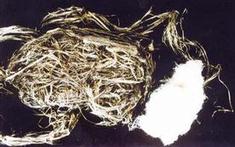 |
Two museum samples of hemp fiber
taken from medicinal varieties of hemp (left). The gray is
weather retted (rotting of the inter-fiber material) and the
white is vat retted in water two weeks and sun bleached. Photo: Bill Bridges |
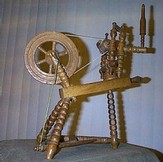 |
This museum model spinning wheel 18 inches high actually works. Years ago the museum borrowed a neighbor and his larger spinning wheel to spin two skeins of yarn one of tow fiber for knitting one of long fiber for rope. The curator knows how to spin for demonstration purposes, but is out of practice. |
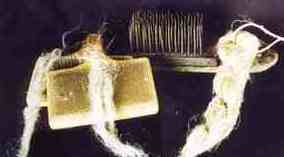 |
After the breaking process
separates the fiber from the wood, the fiber is cleaned by
pulling it through the long tined hetchel. In the
foreground are wool combs which we used on the tow or short
fibers, then spun a nice soft yarn. Photo: Bill Bridges |
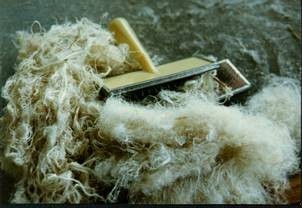 |
The vat retted hemp on the left of
the picture was teased and combed with the wool cards or combs
into batts on the right for spinning into
yarn.
The coarse long fibers of industrial hemp were used for rope and canvas like that seen below on a wagon train. |
USA Hemp Museum Store - Bookmark This Site - Museum Link - Email The Museum